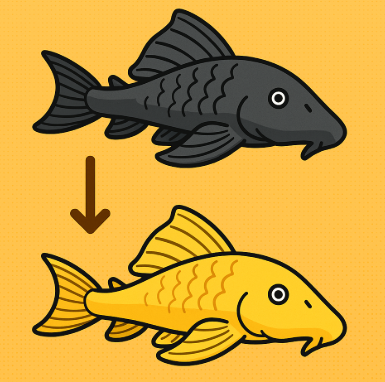Why did my pleco change to a xanthic coloration?
❓ Why Did My Pleco Change to a Xanthic Coloration?
Some plecos can transition into a xanthic color form, where their normal markings shift to a yellowish or sometimes pale whitish appearance. The exact shade depends on the pleco’s natural base coloration.
🟨 What We Know About Xanthic Changes
- The exact reason isn’t fully understood.
- For many plecos, the change is temporary, but it can last for months or even years, and in rare cases, it may become permanent.
- It does not always indicate illness — some healthy plecos display this coloration without other health issues.
Possible Influences on Xanthic Coloration
- Genetics – Some individuals may be predisposed to pigment shifts.
- Environmental Factors – Lighting, background, and substrate color can influence how pigments are expressed.
- Stress & Recovery – Prolonged stress or recovery from injury/shipping can sometimes trigger pigment changes.
- Age & Maturity – Hormonal changes as the fish matures can affect pigmentation.
- Disease Triggers – In some cases, certain diseases or internal infections may disrupt pigment production, leading to a xanthic appearance. This is more likely if the fish also shows weight loss, lethargy, rapid breathing, or loss of appetite.
💡 Tip: If your pleco’s color change is accompanied by normal eating, activity, and no other symptoms, it’s likely a harmless pigment shift. However, if the change occurs alongside illness signs, check water quality immediately and consider consulting a fish health expert.
Preventing & Reversing Chronic Color Fading
1. Water Quality Maintenance 💧
- ✅ Keep ammonia and nitrite at 0 ppm.
- ✅ Maintain nitrate below 20–30 ppm.
- ✅ Match pH, temperature, and hardness to your pleco’s species requirements.
- ✅ Perform weekly water changes (25–40% depending on bioload).
- ✅ Use reliable test kits to check parameters regularly.
2. Nutrition & Diet 🍽
- ✅ Provide high-quality sinking pellets or wafers for plecos.
- ✅ Supplement with fresh vegetables (zucchini, cucumber, spinach, green beans).
- ✅ Add color-enhancing foods with spirulina, krill, or carotenoids 2–3x weekly.
- ✅ Include driftwood for wood-eating species (e.g., Panaque).
3. Lighting & Environment 💡🪵
- ✅ Use moderate lighting; avoid extremes that cause stress.
- ✅ Match tank decor & substrate to the species’ natural environment.
- ✅ Provide multiple hiding spots to reduce stress.
- ✅ Consider darker substrates to enhance pleco coloration.
4. Tankmate Selection 🐟🤝
- ✅ Keep with peaceful or compatible species.
- ❌ Avoid aggressive tankmates that cause stress or injury.

Impulsada por Lightspeed
Mostrar precios en:USD